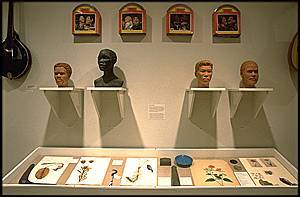 [for larger image] |
Family Handpuppet Theaters
Art Studio Four type busts
Anthropology
The world, in sixteenth-century Europe, was divided into just four continents-- Europe, Asia, Africa, and America--covering the four quadrants of the globe, west, east, north, and south. Of course, later exploration determined that America should be properly divided into two continents, and then revealed Australia and eventually Antarctica. This upset the "natural" division of the world into four balanced parts.
As with the four elements, the four continents could be used as global categories for organizing collections. Again, as new lands, peoples, and materials were gradually discovered, geographers had to restructure their maps of the world, and collectors had to reorganize their collections.
In this display we placed typical objects for five continents (adding Australia to the group) in the cabinet at bottom; just above these we mounted type busts from Anthropology, used to represent physiological differences among different world peoples; and finally, at the top, we included a group of "family hand puppet theaters" from Art Studio, as examples of ethnic types as portrayed by contemporary toy manufacturers.

